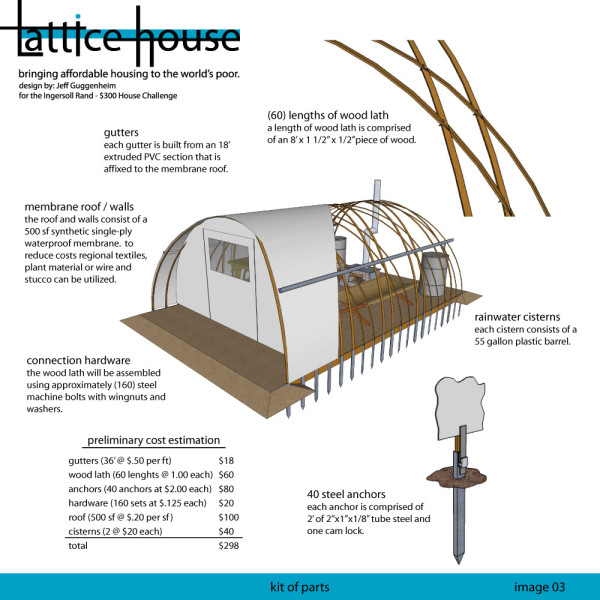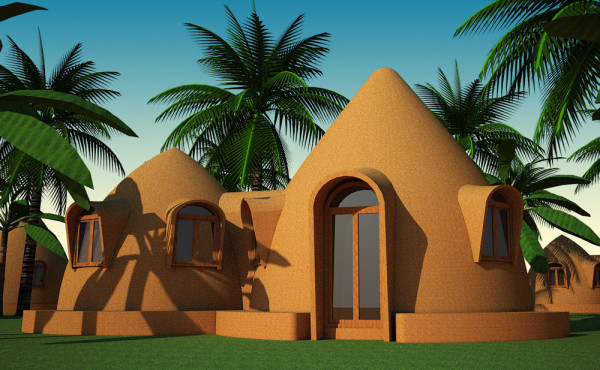The concept of the $300 House Project is based on the 2.5 billion people that make up the bottom of the socioeconomic pyramid. Govindarajan and Sarkar propose basic necessities for surviving in the modern world, from mosquito nets and water filters to solar panels and a tablet PC.
You are invited to put your design skills to the test through a Jovoto competition which is now open for design submissions. A $10,000 prize and a 2-week prototyping workshop with Common is set up for the winner.
I have attached three pictures of my favorite submissions so far. If you are a tiny house designer and want to get involved in this competition join now.




That lattice house is kind of like a quonset yurt.
Sure like to know where the lattice home got their cost estimates from. Can’t find those prices around here.
Here in Mexico those prices are more than reasonable.
But with the Purchasing Power Parity difference between Mexico and the U.S., if you made minimum wage in Mexico and worked full-time, 40 hours a week, it would be the equivalent of about $100K here in the U.S. So, I guess $300 is a real relative number.
I’m with Bill though, I don’t think you can construct that for those prices.
IF ONE CAN BE BUILT FOR 300.00 THEN IT SHOULD BE BUILT ! I DON’T THINK IT CAN BE AND TAKE A LOOK ACROSS THE RIO GRANDE IN EL PASO !
I live the “Versatile Home” design. (any more specs on that??) It offers a little more security and a sturdier exterior for protection of the occupant and their “Stuff” I bought a 1/4 acre of vacant land in central Florida, and have purchased a “Fast Framer” kit to erect a small fishing type cabin. It gets super hot there in the summer but If I made enough window openings I think it would be a good cheap start.The middle class in Florida is losing ground quick and might think about downsizing!!!
I am in Florida also. Where did you find land to build a cabin? And what headaches are the building codes?
I am in agreement with Richard. Here in Florida and many other parts of the country it would be impossible to build such a house for $300 due to highly restrictive building codes. The plans need to be supplemented with structural engineering plans and details that drive up the cost of the house to ensure that it meets the wind loading requirements. Using lattice strips just will not work. Other areas have seismic, lateral soil pressure, snow and other loading that would render this design unbuildable. Maybe in areas where codes are not enforced it could be done, but I wouldn’t want to build a house that the big bad wolf could huff and puff and blow it down with a sneeze.
I see Vinay Gupta on the list of advisors, but I wonder what they think of the plywood hexayurt? You could make a serviceable OSB hexayurt for $300.
Its a very cool, worthwhile project- thanks for posting on it Kent- I’m one of the advisors on their large board of designers, etc. Some funky, great stuff comin’ off that site- and for a great cause too…
-Derek “Deek” Diedricksen
Relaxshacks.com
Hey Deek!! I submitted one of my pallet house designs and we are currently in 5th place!! check it
http://www.jovoto.com/contests/300house/ideas/12576
Its a great idea, it drives innovation certainly, and from what I can see there are some unique designs. But I can’t help feel affordable housing such as these would only help in part towards health and sanitation… And land ownership – well, that’s something else.
I agree with Roy about it being a great idea, its innovation, and unique design. I too feel affordable housing such as these would only help in part. Only with World Health Organization collaboration with non profits in teaching healthy habits and sanitation could refugee camps be turned into safe havens. Then maybe a workable goal toward the same homes beng built on affordable or donated lands for living. Of course, then a way to live and earn a living nearby is needed…GEESH you’d think humans would have gotten it by now!
Low cost housing is always a worthwhile project. In most cases nothing is cheaper than dirt. We are researching better methods to make stronger inexpensive mixtures for adobe building blocks from ordinary dirt, not sand. A very cheap binder is needed. All suggestions will be explored. We need something new that is simple and cheap to make a glue like binder in large quantities from common waste organic material like vegetation. We want to be able to use the earth that is one site. All ideas are welcome.
Thanks,
Walt
I’ve heard of alot of adobe/cobb builders using cattle manure as a binder….of course it doesnt smell like manure when dry.
I need a design for a small house in the range of 5 to 10K. Walt Barrett is the closet so far. He has a good design. This is aimed at transient housing for homeless mothers with 1 child. Tough deal to work with the agencies and building dept. but I want to try to do it. Financing is in place for a trial run. Probably a set of 4 to 6 units. Need to be designed for Colorado weather. Any input is appreciated. Thanks, Bill
So great to see this being discussed here! 🙂
In the lattice house, the illustration shows a floor but the costs estimates do not show the same. So are we talking rammed dirt which is free without the labor, or was this an oversight. A good deck or slab will cost a lot more than $300. Is that a rocket stove in the interior? Shouldn’t that be outdoors in warmer climates which I am assuming this shelter is meant for.
Natural Balance home designer shows us his green home in BC, Canada. Some great features include the green roof that also provides for a gorgeous environment on the rooftop deck with awesome views.